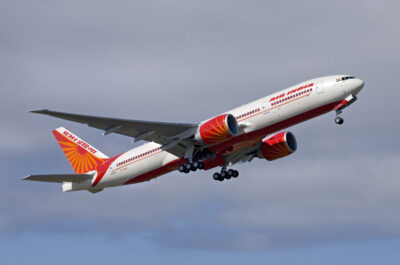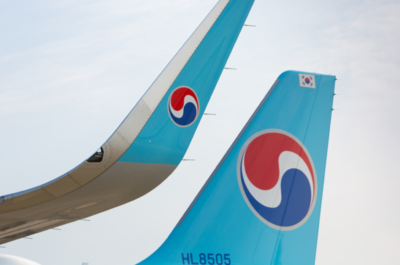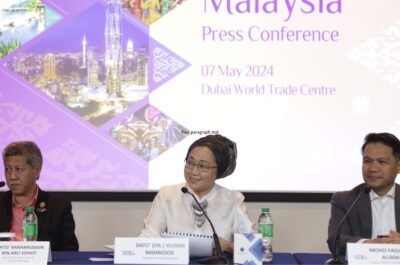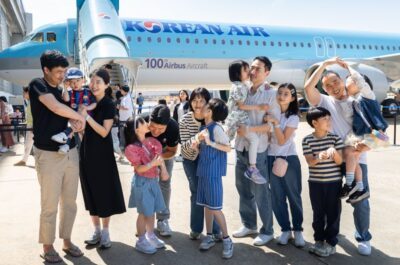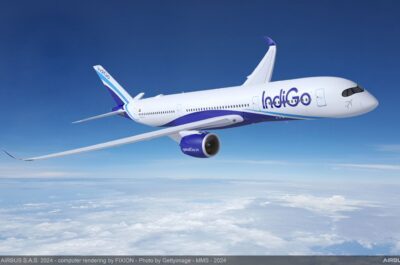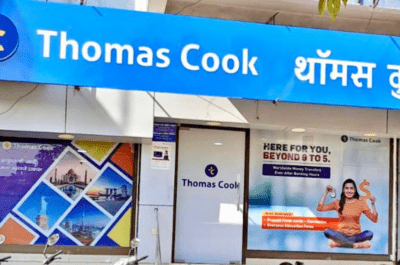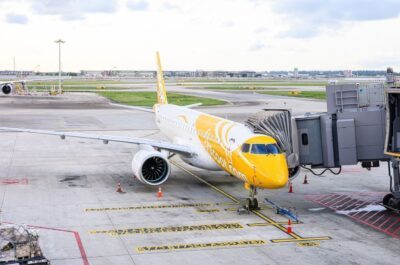After three years of meticulous planning and research, Messe Berlin launched the inaugural ITB Asia at Suntec Singapore, “comfortably exceeding our initial 500-exhibitor target,” said Messe Berlin CEO Mr. Raimund Hosch. The final count was 651 exhibiting companies and organizations from 58 countries and territories worldwide -a far cry from the 12 exhibitors who took part in the first ITB Berlin 42 years ago- with ITB Asia exhibitor space selling out in…
After three years of meticulous planning and research, Messe Berlin launched the inaugural ITB Asia at Suntec Singapore, “comfortably exceeding our initial 500-exhibitor target,” said Messe Berlin CEO Mr. Raimund Hosch. The final count was 651 exhibiting companies and organizations from 58 countries and territories worldwide -a far cry from the 12 exhibitors who took part in the first ITB Berlin 42 years ago- with ITB Asia exhibitor space selling out in just nine months. The number of buyers was announced at 812 carefully-selected, hosted buyers. In addition, there are more than 1,000 trade visitors.
ITB Berlin, which is held annually in March, is the world’s leading international travel show, attracting some 11,000 exhibitors in 2008 from 186 countries and territories. Exhibitors at ITB Berlin this year utilized 160,000 square meters of floor space. ITB Berlin focuses primarily on the European and North American markets. Messe Berlin’s intention, in launching ITB Asia, was to take its trade show expertise, contacts, and technical skills and diversify its well-known brand into a completely new space.
Why Asia? “Because it has a track record of offering impressive economic growth rates,” said Mr. Hosch, “and it also offers a massive population, youthful demographics. and amazing cultural diversity.” Will it work? “All we know at this stage is that buyers and exhibitors have turned out in mass to attend ITB Asia. We have had virtually no cancellations attributed to the new economic crisis. This tells us that in good times or bad, the travel and tourism industry is committed and resilient. In fact, Messe Berlin believes that the global economic crisis has added impetus and importance to the first ITB Asia. We believe ITB Asia delegates correctly saw this week as their chance to come together from all corners of the industry to discuss proactive policies and plans for the recovery to come.”
Both Messe Berlin and the Singapore Tourism Board (STB), its strategic partner in the new venture – “without whom we could never have hoped to achieve such fantastic support across the whole of Asia” – believe the staging of ITB Asia has proved timely. As the first international travel trade show in Asia to be held after the tumultuous events of the past couple of months, ITB Asia is being seen as a barometer of business confidence in the future of travel and tourism demand. The strategic partnership between Messe Berlin and STB covers a minimum of three years, but Messe Berlin fully expects it to continue in the long term, attracting strong growth in exhibitors and buyers/trade visitors year on year.
Whether or not ITB Asia will also be opened up to the public is yet to be decided. “This will depend on what our exhibitors want,” said Mr. Hosch.
Singapore predicts tourism boost by 2010
Following three years of consistently strong growth in annual arrivals, culminating in 10.3 million in 2007 and averaging around 7% between 2004 and 2007 – with international tourism receipts up an even more impressive 12% a year over the period – Singapore, like other Asian destinations, has suffered a slowdown in 2008. Growth started to falter from April, moving into negative figures in the months of July through August, and resulting in a stagnation in total arrival numbers for the first nine months of this year. “We are still going to achieve a count of more than 10 million,” said Mr. Lim Neo Chian, deputy chairman and chief executive of the Singapore Tourism Board (STB). While he admitted the current trend is disappointing, he said the STB is confident of a recovery by 2010 at the latest. “Singapore’s annual calendar over the next few years will be packed chock-full of exciting events which will give new momentum for growth,” said Mr. Ken Lowe, STB’s assistant chief executive (Brand and Communications) at a press conference held October 22 at ITB Asia.
Among the many new products and attractions scheduled to come on line by 2010 are the Marina Bay Sands Resort and Resorts World at Sentosa, which will also include Universal Studios. Cruise capacity is being doubled over the next two years, with the number of cruise passengers forecast to reach 1.6 million by 2015 and, among the new events scheduled, will be the first Southeast Asia stopover of the Volvo Ocean Yacht Race. Singapore will also host the inaugural Youth Olympic Games in 2010 and the SingTel Formula One Grand Prix is now an annual event. Similarly, ITB Asia – organized by Messe Berlin in partnership with STB – is expected to grow from strength to strength in the coming years.
“The staging of ITB Asia here comes at a time when the global tourism and economic markets face an uncertain future,” said Mr. Lim. “However, as a marketplace, ITB Asia will allow Asian and global players to explore new business opportunities, build relationships, and network more. In line with its efforts to promote Singapore’s multiple attractions for both leisure and business visitors, STB took the opportunity of its strong presence at ITB Asia to unveil ‘Singapore Kaleidoscope,’ a new design concept that will characterize its presence at various international trade shows in the coming months. Singapore Kaleidoscope is aimed at reflecting Singapore’s energetic personality and its many attractions as a multi-faceted city that is constantly evolving and intriguing from every perspective,” said Mr Lowe.
Local loyalties win the day in India
Within India, regional reach and local brand loyalties tend to triumph over national brands and strategies. That was the view of panellists at the Web in Travel session called “Market Ideas: India” which took place October 22 at ITB Asia. Such a trend is not surprising, the travel experts said, considering the Indian marketplace has 25 official languages and over one billion people
“It is important to adopt a multi-lingual approach given India’s economic, cultural and demographic landscape, to understand the critical aspects of India’s travel and online travel, the dynamics that make this market so unique, and the essential strategies required for success,” said Mr. Dhruv Shiringi, CEO of India-based Yatra.com. “It is for this reason that international portals such as Expedia and Travelocity had been unsuccessful in making inroads into the Indian online travel market,” Shiringi explained. Online travel portal Yatra.Com, generates a monthly turnover of US$17.5 million, the bulk of which comes from domestic flights.
Mr Phanindra Sama, co-founder and CEO of Redbus, India’s largest bus tickets aggregator, made it clear that it was important to identify a target market and concentrate on servicing this sector. The top 10% of income earners is responsible for 30% of the market turnover, he said. Members of the panel agreed that the financial meltdown in the global market had little impact on India’s online travel market which is predominantly based on domestic travel. In fact, travel is the largest e-commerce category in India. There are at least a dozen portals in India’s online travel market, which is pegged at around US$2 billion and expected to grow to US$6 billion by 2010, according to PhoCusWright, Inc. Wanderlust-struck Indians are visiting these sites to hunt for the most affordable airline tickets, hotel rooms, and tour packages, said session moderator, Mr. Ram Badrinathan, senior director, research of PhoCusWright, Inc.
The speakers at the session agreed that India’s online travel market was at the intermediate stage with a great deal of potential for significant expansion. “India has achieved this level of growth with third-grade infrastructure, so there is much more that can be achieved,” said Mr. Keyur Joshi, co-founder of Makemytrip.com. “Investment is pouring into the travel industry in India across the value chain, including aviation infrastructure (airports), roads, railways, airlines, hospitality, and travel retailing.”
Makemytrip.com is one of the major tour operators in the country with 22 locations in India. According to PhoCusWright, the total base of internet users in India is estimated at 49.4 million, with one in five users coming from rural areas. Of these, 82% of online Indians come from urban areas while 18% are from rural areas. At these levels, the penetration of internet stands at 4.5% of the total population of India.
In crisis, focus on customer needs
In times of turmoil, brands are a necessity, but companies should not overuse them. Panelists at the Web in Travel event, “New Ideas & Execution for Brand Building & Marketing” at ITB Asia on October 22 said the focus should be on customer needs during a downturn. “Crisis always opens new opportunities to change the way we do business. In a crisis, the company must get very focused on customers needs,” said Mr. Gerry Oh, regional vice president, Southeast Asia and Australia for Jet Airways (India). Panelists said values, loyalties, and customer priorities change in a crisis. “The crisis translates into budget constraints for consumers. It generates new market segments with core values being very much the message of the day,” said Mr. Roland Jegge, vice president, Asia Pacific of Worldhotels. In times of fiscal uncertainty, boosting advertising and PR activities builds up brand loyalty and stimulates consumer confidence. “Being present in advertisements shows that the company is still doing well,” said Ms. Kathleen Tan, vice president, Marketing for AirAsia.
Panelists said that brands in Asia have generally developed in the shadow of Western ones, which have had a longer presence in global markets. The travel experts in the session said that Asian companies have for too long paid little attention to branding. Furthermore, Asian companies often experience difficulties coping with local differences within markets. Speakers also said that another difficult task for local brands, in part, comes from a pan-Asia preference for Western brands, which are perceived as a symbol of economic affluence. Ms. Tan said that AirAsia – probably the most recent example of a successful pan-Asian brand – had to learn a lot from differences within the region. Ms. Tan said, “We had to adapt our website to different languages across the region with specific messages. In China, we had to introduce a special translation of AirAsia in Mandarin with a specific website in Chinese Mandarin once we learned from our Chinese partners that they did not understand Mandarin from Malaysia.”
Nevertheless, all speakers said that Asia has been able over the years to build up strong tourism brands. “Hotels, spas and destinations around the region are perceived as high-quality, stress-free, tourism products. In this sense, Asia has been doing better than many Western countries,” said Mr. Gordon Locke, vice president, Airline Marketing and Strategy at Sabre Airline Solutions. Speakers said that Asian companies need to allocate more resources to digital marketing, which is today an essential tool for building up a global presence.
China: A promising but difficult online travel market
Although China continues to be the world’s most promising market for expansion, penetrating the market remains a hard task for e-service companies. That was the warning expressed at the Web in Travel “Marketing Ideas: China” session, which took place during ITB Asia on October 22. In China, e-technology often remains in its infancy. “Some 80% of all bookings are still offline for business travelers as they generally only travel with a cell phone,” said Mr. Alfred Chang, director of Business Development for Ctrip, one of China’s largest online companies. Business travel is characterized by last-minute decisions. This means good opportunities for online booking companies. A major challenge, however, is the dominance of local Chinese online company Travelsky.com. The reservation system is present in 229 Chinese cities, 79 international ones, and connects 5,200 business units through 20,000 terminals located in China.
Speakers said another major hurdle is an extremely fragmented hotel market. According to Mr. Chang, only 10% of all hotels in China are part of an international hotel chain. Less than 5% of all tickets on Chinese airlines are booked online, as websites do not offer the same level of sophistication as their counterparts in the rest of the world. Group travelers remain of low value as they abide by the motto “10 countries in 9 days.” “Those travelers do not care about their experience. They just want to have ‘been there,’” said Mr. Chang, who observed that they also travel on very tight budgets. Independent Chinese travelers spend a lot of time on the internet looking for information, but they are constrained by tight travel budgets. Only vacationers have discretionary spending power and represent an interesting target for e-booking companies, said Mr. Chang.
A further hurdle e-companies must deal with, is the influence of the Chinese government on travel, said Mr. Fritz Demopoulos, CEO of Gunar.com, a major online travel provider. “The government can easily discourage travelers to a destination or block travel if necessary,” he said. “It most recently happened during the Beijing Olympics when the government restricted visa issuing as well as MICE activities.” China has the largest number of internet users in the world with 250 million. They also have 600 million mobile phone subscribers. He described the Chinese as web-savvy, as 60% of them use the internet for travel research. However, they still feel reluctant to embrace online travel, especially online payments. Mr. Demopoulos said, “It is easy to lure the Chinese into subscribing to a web provider or to become a client of a credit card company. However, it is hard to make them pay online or use credit cards for e-services.” Mr. Demopoulos concluded, “There is no secret in coping with the Chinese market. It is fun – but you must get your hands dirty.”
Theodore is the Co-Founder and Managing Editor of TravelDailyNews Media Network; his responsibilities include business development and planning for TravelDailyNews long-term opportunities.








